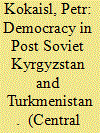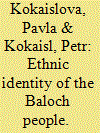|
|
|
Sort Order |
|
|
|
Items / Page
|
|
|
|
|
|
|
| Srl | Item |
| 1 |
ID:
085841


|
|
|
|
|
| Publication |
2008.
|
| Summary/Abstract |
The economic impact of globalization usually draws the most attention, while the accompanying aspects, which may include the transformation of an entire culture, are mentioned only secondarily. However, deeper transformational changes occur in culture and the social structure, which also affects changes in an individual's thinking and reasoning.
|
|
|
|
|
|
|
|
|
|
|
|
|
|
|
|
| 2 |
ID:
118742


|
|
|
|
|
| Publication |
2012.
|
| Summary/Abstract |
The national self-awareness of the Balochis, who live in several countries and have no statehood, is very specific in many ways. The problem of their identity can be better understood in the context of certain parallels between them and European peoples (ethnic groups), since their ethnogenesis displays certain common features. We should bear in mind, however, that the formation and development of the Balochis differed in many respects from those of the European peoples.
The Balochis of Iran, Afghanistan, Pakistan, and Turkmenistan are not absolutely identical, in this respect they differ greatly from the Europeans.
|
|
|
|
|
|
|
|
|
|
|
|
|
|
|
|
| 3 |
ID:
160020


|
|
|
|
|
| Summary/Abstract |
The main objective of this study was to illustrate the cultural changes that have taken place among Korean ethnic groups living in the Central Asian states of the former Soviet Union. Previous research on Korean minorities has demonstrated the impact of state intervention on the formation of ethnic identity. Despite a wide range of regional differences, those living in Korea in the nineteenth century belonged to one ethnic group. Once they left the northern part of the country for Russia, they began to adopt Russian culture relatively quickly. Following their deportation to Central Asia in the 1930s, they then experienced a largely Soviet model of inclusion into mainstream society. However, since the 1980s, when confronted with ‘original’ Korean culture, they now consider themselves to be dissimilar to other Korean groups. The differences are already so substantial that Koreans themselves now talk about belonging to different nations.
|
|
|
|
|
|
|
|
|
|
|
|
|
|
|
|
| 4 |
ID:
122654


|
|
|
|
|
| Publication |
2013.
|
| Summary/Abstract |
This paper traces changes in the culture of the Kyrgyz ethnic group in the era after the break-up of the USSR. In order to describe correctly changes in their lives, a comparison was used from a wide range of areas where Kyrgyz live. As a basis, the way of life of Kyrgyz in Kyrgyzstan is used. Kyrgyz here represent the majority, but before the break-up they did not emphasize their ethnicity significantly. After the break up of the USSR and the formation of the national state, they began to look for new, or new-and-old, roots and to strengthen their nationalistic tendencies. Looking for new roots included the creation of historical constructs and emphasizing many specifics of lifestyles of 'real Kyrgyz'. But Kyrgyz live in many other states as a minority - especially in China, Tajikistan and Afghanistan. These Kyrgyz, however, often designate different elements of their culture as a basis of their ethnic group compared to Kyrgyz from Kyrgyzstan. The paper first tries to identify important elements of Kyrgyz culture in the era of the break-up of the USSR based on statements of respondents from Kyrgyzstan and to find out if these elements are also important as an identification feature for Kyrgyz in other states. Field research has been conducted in China and Tajikistan, but in this work, results from Afghanistan in particular are presented. The paper also tries to give an answer as to the influence of the formation of the national state (Kyrgyzstan) on members of ethnic groups living in other states as a minority (Kyrgyz in Afghanistan) and how this changed their ethnic identity.
|
|
|
|
|
|
|
|
|
|
|
|
|
|
|
|
|
|
|
|
|